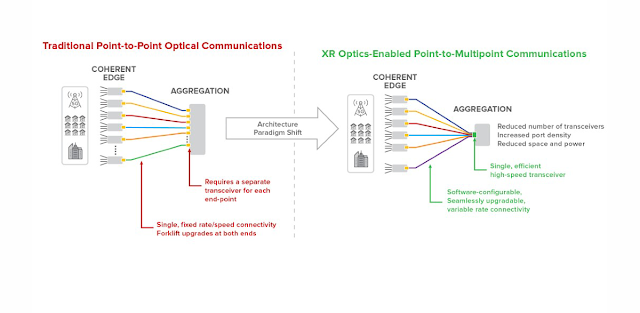Inphi announced volume production of its 100Gbps and 400Gbps Single-Lambda Pulse Amplitude Modulation (PAM4) platform for data center and cloud networking applications.
Inphi’s Porrima PAM4 platform is a 56GBaud solution that includes linear TIA and drivers.
“Production availability of our Porrima PAM4 platform is aligned well with the data center expansion and is critical to meeting the rapidly increasing bandwidth needs in today’s cloud computing and hyper-scale data center environments,” said Eric Hayes, SVP, Networking Interconnect at Inphi. “Inphi continues to expand its technology and market leadership position in PAM4 data center and cloud infrastructure, and as a result are seeing a tremendous amount customer design win momentum supporting our now six generations of DSP developments. Inphi continues to drive next generation optical designs providing an ease of use API-based DSP software suite that achieves quick time-to-market with the right trade-offs in power and performance for data center optical interconnects.”
Porrima PAM4 DSP Product Family:
 Porrima PAM4 DSP IC provides a full bi-directional interface with host ASICs that have 28GBaud PAM4and NRZ electrical interfaces, while bridging to 56GBaud optics. The product family can support PAM4 or NRZ signaling, and both Retiming and Gearbox functionality with packaging specifically designed for the following optics modules:
Porrima PAM4 DSP IC provides a full bi-directional interface with host ASICs that have 28GBaud PAM4and NRZ electrical interfaces, while bridging to 56GBaud optics. The product family can support PAM4 or NRZ signaling, and both Retiming and Gearbox functionality with packaging specifically designed for the following optics modules:
Porrima Linear Drivers:
The IN5630DE/IN5634SE is a 56GBaud low power single/quad linear driver for PAM4 optical modules. Features include:
Porrima Linear TIA’s:
The IN5661TA/5664TA is a 56GBaud low power single/quad linear TIA for PAM4 optical modules. Features include:
Inphi’s Porrima PAM4 platform is a 56GBaud solution that includes linear TIA and drivers.
“Production availability of our Porrima PAM4 platform is aligned well with the data center expansion and is critical to meeting the rapidly increasing bandwidth needs in today’s cloud computing and hyper-scale data center environments,” said Eric Hayes, SVP, Networking Interconnect at Inphi. “Inphi continues to expand its technology and market leadership position in PAM4 data center and cloud infrastructure, and as a result are seeing a tremendous amount customer design win momentum supporting our now six generations of DSP developments. Inphi continues to drive next generation optical designs providing an ease of use API-based DSP software suite that achieves quick time-to-market with the right trade-offs in power and performance for data center optical interconnects.”
Porrima PAM4 DSP Product Family:
 Porrima PAM4 DSP IC provides a full bi-directional interface with host ASICs that have 28GBaud PAM4and NRZ electrical interfaces, while bridging to 56GBaud optics. The product family can support PAM4 or NRZ signaling, and both Retiming and Gearbox functionality with packaging specifically designed for the following optics modules:
Porrima PAM4 DSP IC provides a full bi-directional interface with host ASICs that have 28GBaud PAM4and NRZ electrical interfaces, while bridging to 56GBaud optics. The product family can support PAM4 or NRZ signaling, and both Retiming and Gearbox functionality with packaging specifically designed for the following optics modules:- Porrima 400G – 8x56Gbps PAM4 <-> 4x100Gbps PAM4 for QSFP-DD/oSFP/COBO
- Porrima 100G – 4x25Gbps NRZ <-> 1x100Gbps PAM4 for QSFP
- Porrima 100G – 2x50Gbps PAM4 <-> 1x100Gbps PAM4 for QSFP/uQSFP/SFP-DD

Porrima Linear Drivers:
The IN5630DE/IN5634SE is a 56GBaud low power single/quad linear driver for PAM4 optical modules. Features include:
- Excellent linearity, high bandwidth, adjustable gain to optimize the PAM4 system performances
- Low-power modulator driver in small package or in bare die form
Porrima Linear TIA’s:
The IN5661TA/5664TA is a 56GBaud low power single/quad linear TIA for PAM4 optical modules. Features include:
- Wide dynamic range to meet the different performance and link requirements for optical applications
- Excellent signal integrity necessary for PAM4 modulation schemes
- Low-power and small form factor
























